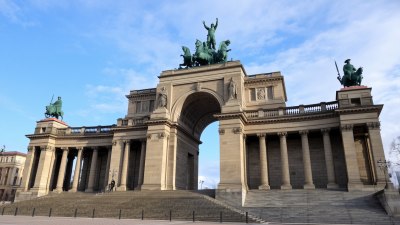The Völkerschlachtdenkmal in Germany Still Dreams in Stone
Explore the history and significance of the Völkerschlachtdenkmal, a monumental tribute in Germany. Discover its stories and architectural marvel.

Image created with Flux Schnell
The Völkerschlachtdenkmal, or the Monument to the Battle of the Nations, stands proudly in Leipzig, Germany, as a testament to a pivotal moment in European history. Completed in 1913, this monumental structure commemorates the decisive battle that took place in October 1813 during the Napoleonic Wars. Over the course of four days, coalition forces consisting of Russia, Prussia, Austria, and Sweden clashed with Napoleon's army in what would become a turning point for European power dynamics.
As one of the largest monuments in Europe, the Völkerschlachtdenkmal rises an impressive 91 meters and is a remarkable example of German nationalism and pride following their victory. The structure is not just a memorial for the fallen but also a celebration of unity among diverse nations fighting against a common enemy. Designed by architect Bruno Schmitz, the monument's Neo-Romanesque style reflects the grandeur and ambition of its time, intermingling with the historical context of early 20th century Germany.
Upon approaching the monument, visitors are immediately struck by its immense size and intricate details. The façade is adorned with an array of sculptures and reliefs, depicting not just the soldiers who fought but also allegorical figures representing valor, sacrifice, and welcoming peace. At its base, enormous stone figures of warriors stand vigil, embodying the heroism of those who laid down their lives for their nations.
Entering the monument, one descends into a crypt that holds a somber atmosphere with illuminated carvings of the fallen soldiers. It resonates with the one-hundred-thousand men who died in the battle, bringing a heavy sense of reverence. This underground chamber serves as a reminder of the human tragedy that accompanies warfare, evoking reflection and contemplation.
Architectural Features
The design of the Völkerschlachtdenkmal is highly symbolic, incorporating elements that speak to both the historical event it commemorates and the architectural trends of the early 20th century. The monument’s four massive statues at each corner visually represent the four nations of the coalition. Each figure portrays a distinct character: a Russian warrior with a bear, a Prussian soldier with a sword, an Austrian nobleman with a majestic armory, and a Swedish soldier with a halberd. Together, they symbolize the unity and strength of the nations working in concert against Napoleon.
Above these allegorical warriors, the main structure rises with force, crowned by an enormous statue of a resolute soldier holding a sword aloft, a sight that inspires both awe and determination among visitors. The architectural design embodies the sense of triumph that those who built it wanted to portray, cementing the significance of the battle in national consciousness. Each element is meticulously crafted, with the use of Quarry stone enhancing the monument's weight and authenticity, inviting not just admiration but also wonder at human creativity and craftsmanship.
Historical Context and Legacy
The significance of the Völkerschlachtdenkmal extends beyond its physical presence; it is woven into the fabric of German identity. In the years following the battle, Germany was undergoing a radical transformation due to the emerging sense of nationalism. The monument was conceived during a time when Germany was aspiring to unify under a single empire, heightening the importance of showcasing national pride.
This desire for unification found symbolic representation in the Völkerschlachtdenkmal. As Germany progressed through the 19th and early 20th centuries, the monument emerged as a rallying point for nationalist sentiment, inspiring generations with a sense of purpose and collective identity. Events often held at the monument served to instill pride among German citizens, reinforcing the values of unity and strength borne from shared history.
A Site of Reflection
In the modern era, the Völkerschlachtdenkmal remains a vital historical site, drawing millions of visitors each year. As people walk through its colonnades, they are invited not only to reflect on the past but also to engage with pertinent discussions relating to war, peace, and the consequences of conflict. The monument's memorial aspect encourages contemplation of the true cost of warfare, as it honors those who made the ultimate sacrifice in pursuit of freedom.
Moreover, the site is often the stage for numerous cultural events, including concerts, festivals, and commemorative gatherings that seek to bridge the past with the present. This act of remembrance encapsulates the ongoing journey of humanity, where lessons learned from history foster resilience and the pursuit of peace. The monument stands, unwavering, as a call to reflect on the turbulent past while encouraging conversations about a united future.
Navigating the Surroundings
The grounds surrounding the Völkerschlachtdenkmal are also steeped in history and beauty, offering visitors an enriching experience beyond the monument itself. The landscaped parks and gardens are ideal spots for leisurely strolls, providing a serene atmosphere contrasting with the monument's imposing stature. Visitors can explore surrounding sites such as the Museum für bildende Kunst and the Panometer, which adds to the depth of historical context and artistic inspiration offered to guests.
Additionally, the monument’s strategic position allows for easy access to Leipzig's city center, enabling travelers to dive deeper into the vibrant cultural tapestry the city has to offer. From its rich architectural landmarks to lively markets and cafes, the city serves as a backdrop to the enduring story of the Völkerschlachtdenkmal and its continued relevance in contemporary society.
A Dream in Stone
The Völkerschlachtdenkmal embodies a narrative that intertwines resilience, sacrifice, and unity. Its presence serves as a powerful reminder of the shared history of nations coming together and the immense costs of conflict. As generations pass, the monument continues to dream in stone, whispering stories of the past, instilling hope for a future defined by understanding and collaboration. Visitors may find themselves drawn not just to its physical form but to the deeper meanings and emotions it evokes, prompting them to reflect on both the triumphs and tragedies of history.
Ultimately, the Völkerschlachtdenkmal invites us to remember, to learn, and to aspire towards a united future where the attainments of peace and cooperation carry greater weight than the scars of war.











